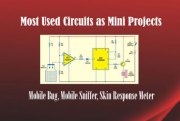A Zener diode is designed to operate in the Reverse breakdown region. If a silicon diode is reverse biased, a point will reach where its reverse current suddenly increases. The voltage at which this occurs is known as “Avalanche or Zener “value of the diode. Zener diodes are widely used as voltage regulators to give fixed voltage to circuits.Using a Zener diode, it is very easy to make an Over voltage protection circuit. See the design note of Zener regulation .
Zener diodes are specially made to exploit the avalanche effect for use in ‘Reference voltage ‘regulators. Zener diodes are available with voltage rating from 1.2 volts to 48 volts or more. Typical values are : 1.2 V, 2.2V, 3.1V,4.7V,5.1V,5.6V,6.2V,8.2V,9.1V,10V,11V,12V,14V,18V,24V,36V,48,56V,68V etc. Power rating may be 400mW,1W,1.5W etc.
A Zener diode can be used to generate a fixed voltage by passing a limited current through it using the series resistor (R). The Zener output voltage is not seriously affected by R and the output remains as a stable reference voltage. But the limiting resistor R is important, without which the Zener diode will be destroyed. Even if the supply voltage varies, R will take up any excess voltage. The value of R can be calculated using the formula
Where Vin is the input voltage, Vz output voltage and Iz current through the Zener
In most circuits, Iz is kept as low as 5mA. If the supply voltage is 18V, the voltage that is to be dropped across R to get 12V output is 6volts. If the maximum Zener current allowed is 100 mA, then R will pass the maximum desired output current plus 5 mA. So the value of R appears as
R = 18 – 12 / 105 mA = 6 / 105 x 1000 = 57 ohms
Power rating of the Zener is also an important factor to be considered while selecting the Zener diode. According to the formula P = IV. P is the power in watts, I current in Amps and V, the voltage. So the maximum power dissipation that can be allowed in a Zener is the Zener voltage multiplied by the current flowing through it. For example, if a 12V Zener passes 12 V DC and 100 mA current, its power dissipation will be 1.2 Watts. So a Zener diode rated 1.3W should be used.
Over Voltage Protection
This simple circuit can be interfaced between the power supply and the circuit board. Most of the CMOS devices require a low voltage of 5V DC and if the voltage rises, the device may damage instantly. This circuit protects the device if the voltage increases above 6.2 volts. When the voltage is 5 volts, Zener will be out of conduction and the device works normally. If the voltage increases to 6.2 volts or more, Zener conducts and SCR fires. It then carries the current to the ground. The SCR remains latched till the power supply is switched off.













One thought on “Design Your Circuit. Part III – Over Voltage Protector”
1 Pingback
Comments are closed.